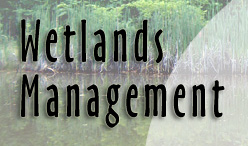Moderately wet bottomland hardwood forests are found on
fertile, fine textured clay or loam soils of floodplains,
stream terraces and wet lowland flats. Soils found in
bottomland hardwoods are less acidic and are enriched by the
influx of nutrients and sediments during floods. The wooded
habitats are composed of hydrophytic plants that grow and
persist despite periodic low oxygen conditions in the soil.
Flooding plays a major role in maintaining bottomland
hardwood forests. Changes between wet and dry periods help
to maintain the health of the ecosystem and eliminate
species that cannot tolerate both. Frequent flooding in
bottomland forests promotes the storage of water within
organic matter for use in dry periods. It also slows down
the decay of vegetative matter, allowing nutrients to build
up. Floodwaters bring sediments and nutrients that settle
into the soil. During drought, periods leaf litter decays
quickly because the soil is exposed to oxygen. This allows
the nutrients to be released so plants and trees can use
them. Floodwaters help many trees to disperse their seeds.
Some seeds are carried directly by water, while others may
be eaten by fish or other wildlife and dispersed to new
locations indirectly.
A variety of duck species,
wild turkey, woodcock, and many songbirds are found near
flooded hardwoods. These areas are also preferred nesting
sites for various cavity dwellers, such as wood ducks, owls,
woodpeckers, and squirrels. Along with the resident species
of wildlife, many migrating birds and waterfowl use
bottomland hardwoods each year. Several threatened or
endangered species may be found in these habitats, including
the Florida panther and both Bachman's and Swainson's
warblers. |

